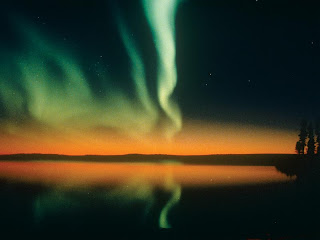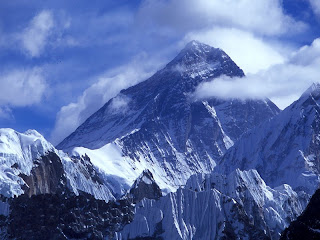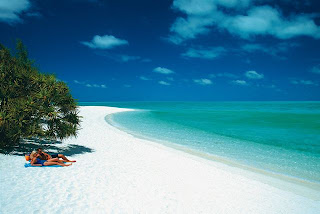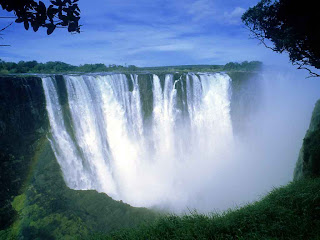The GRAND CANYON (USA)
The Grand Canyon of the Colorado River is the largest gorge in the world-a 290-mile-long gash across the face of the Colorado Plateau in northern Arizona. Rim to rim, it measures up to 18 miles across, with an average width of 10 miles; its average depth is one mile. Within this Delaware-size area of eroded rock rise mountains higher than any in the eastern United States and that dark walls of gorges millions of years old. Agent of this scene, the Colorado River drops 2,200 feet over nearly 200 rapids as it roars through the Canyon toward the Gulf of California.
The NORTHERN LIGHTS (Northern Europe)
Northern lights, or Aurora borealis brings together two mythological deities - Aurora, the Roman goddess of the dawn, and Boreas, Greek god of the north wind - to describe an event witnessed mostly at night in the high northerly latitudes.
Mount EVEREST (the Himalayas)
Mount Everest is a rock and snow peak of the Himalayas. It is in Nepal and stands on the border of Tibet. The expedition which first reached the summit, in 1953, was the eighth to make the attempt; there had also been three reconnaissance expeditions. The peak was named after Sir George Everest. Its Tibetan name is Chomolungma. It is the highest mountain in the world. Its height is 29,028 ft. (8,848 m)
The GREAT BARRIER REEF (Australia)
Spanning more than 2000 km along the northeastern coast of Australia, the Great Barrier Reef is home to thousands of species of plants and animals. The Reef which runs parallel to the Queensland coast has been designated by the Australian Government as a Marine Park.
The VICTORIA FALLS (Zambezi, Africa)
Victoria Falls is one of the world's most spectacular waterfalls. The falls are situated on the Zambezi River, which at this point forms the border between Zambia and Zimbabwe. The falls are broad at roughly a mile (1.6 km) wide, while their height is considerable at 128 m (420 ft). They form a remarkable spectacle because of their peculiar geography — the water falls into a narrow slot-like chasm, and so one can view the falls face-on.
Mountains at RIO de JANEIRO (Brazil)
On the east coast of Brazil, the city of Rio de Janeiro hugs the steep hillsides that meet the magnificent Guanabara Bay and Atlantic Ocean.
PARICUTIN volcano (Mexico)

Paricutin exploded out of a Mexican cornfield about 200 miles (322 kilometers) west of Mexico City in early 1943, giving the modern world its first opportunity to witness the birth of a volcano. The lava eventually covered about 10 square miles (25 square kilometers).
 The Grand Canyon of the Colorado River is the largest gorge in the world-a 290-mile-long gash across the face of the Colorado Plateau in northern Arizona. Rim to rim, it measures up to 18 miles across, with an average width of 10 miles; its average depth is one mile. Within this Delaware-size area of eroded rock rise mountains higher than any in the eastern United States and that dark walls of gorges millions of years old. Agent of this scene, the Colorado River drops 2,200 feet over nearly 200 rapids as it roars through the Canyon toward the Gulf of California.
The Grand Canyon of the Colorado River is the largest gorge in the world-a 290-mile-long gash across the face of the Colorado Plateau in northern Arizona. Rim to rim, it measures up to 18 miles across, with an average width of 10 miles; its average depth is one mile. Within this Delaware-size area of eroded rock rise mountains higher than any in the eastern United States and that dark walls of gorges millions of years old. Agent of this scene, the Colorado River drops 2,200 feet over nearly 200 rapids as it roars through the Canyon toward the Gulf of California. Northern lights, or Aurora borealis brings together two mythological deities - Aurora, the Roman goddess of the dawn, and Boreas, Greek god of the north wind - to describe an event witnessed mostly at night in the high northerly latitudes.
Northern lights, or Aurora borealis brings together two mythological deities - Aurora, the Roman goddess of the dawn, and Boreas, Greek god of the north wind - to describe an event witnessed mostly at night in the high northerly latitudes. Mount Everest is a rock and snow peak of the Himalayas. It is in Nepal and stands on the border of Tibet. The expedition which first reached the summit, in 1953, was the eighth to make the attempt; there had also been three reconnaissance expeditions. The peak was named after Sir George Everest. Its Tibetan name is Chomolungma. It is the highest mountain in the world. Its height is 29,028 ft. (8,848 m)
Mount Everest is a rock and snow peak of the Himalayas. It is in Nepal and stands on the border of Tibet. The expedition which first reached the summit, in 1953, was the eighth to make the attempt; there had also been three reconnaissance expeditions. The peak was named after Sir George Everest. Its Tibetan name is Chomolungma. It is the highest mountain in the world. Its height is 29,028 ft. (8,848 m) Spanning more than 2000 km along the northeastern coast of Australia, the Great Barrier Reef is home to thousands of species of plants and animals. The Reef which runs parallel to the Queensland coast has been designated by the Australian Government as a Marine Park.
Spanning more than 2000 km along the northeastern coast of Australia, the Great Barrier Reef is home to thousands of species of plants and animals. The Reef which runs parallel to the Queensland coast has been designated by the Australian Government as a Marine Park. Victoria Falls is one of the world's most spectacular waterfalls. The falls are situated on the Zambezi River, which at this point forms the border between Zambia and Zimbabwe. The falls are broad at roughly a mile (1.6 km) wide, while their height is considerable at 128 m (420 ft). They form a remarkable spectacle because of their peculiar geography — the water falls into a narrow slot-like chasm, and so one can view the falls face-on.
Victoria Falls is one of the world's most spectacular waterfalls. The falls are situated on the Zambezi River, which at this point forms the border between Zambia and Zimbabwe. The falls are broad at roughly a mile (1.6 km) wide, while their height is considerable at 128 m (420 ft). They form a remarkable spectacle because of their peculiar geography — the water falls into a narrow slot-like chasm, and so one can view the falls face-on. On the east coast of Brazil, the city of Rio de Janeiro hugs the steep hillsides that meet the magnificent Guanabara Bay and Atlantic Ocean.
On the east coast of Brazil, the city of Rio de Janeiro hugs the steep hillsides that meet the magnificent Guanabara Bay and Atlantic Ocean.
 Paricutin exploded out of a Mexican cornfield about 200 miles (322 kilometers) west of Mexico City in early 1943, giving the modern world its first opportunity to witness the birth of a volcano. The lava eventually covered about 10 square miles (25 square kilometers).
Paricutin exploded out of a Mexican cornfield about 200 miles (322 kilometers) west of Mexico City in early 1943, giving the modern world its first opportunity to witness the birth of a volcano. The lava eventually covered about 10 square miles (25 square kilometers).
No comments:
Post a Comment